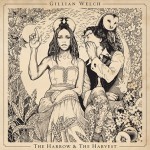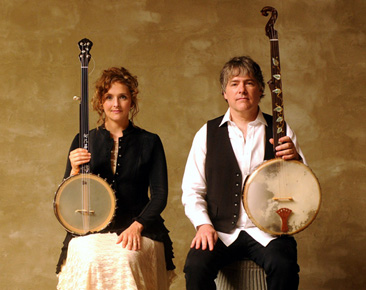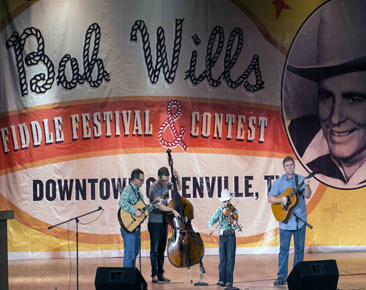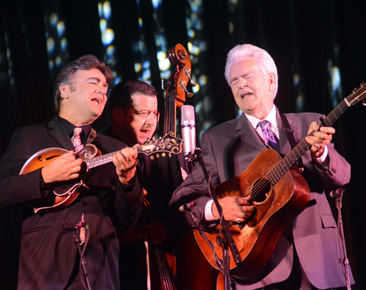 If America has a post-country, post-bluegrass songwriter laureate, one who has absorbed and transcended the idioms of those genres to create a body of work that both mythologizes and humanizes a segment of American life as well as novelists like John Steinbeck and Cormac McCarthy, it has to be Gillian Welch.
If America has a post-country, post-bluegrass songwriter laureate, one who has absorbed and transcended the idioms of those genres to create a body of work that both mythologizes and humanizes a segment of American life as well as novelists like John Steinbeck and Cormac McCarthy, it has to be Gillian Welch.
Welch and her partner—musical and perhaps otherwise, they’re cagey about that—David Rawlings returned to their hometown Nashville Dec. 1 for the first of a two-night after a months-long tour in support of The Harrow and the Harvest, their fifth studio album which was just nominated for the best folk album Grammy.
The Thursday show was their first headlining the hallowed Ryman, where much of the musical history Welch draws on first went out to the world. They both seemed a bit nervous, strange for a duo that’s created such a rich, if minimalist, sound for more than fifteen years. Rawlings, frustrated by a cool draft that was playing havoc with the tuning of his already legendary 1935 Epiphone Olympic, described the situation as “an actual nightmare.”
The music, of course, was a dream. Beginning with Scarlet Town and Dark Turn of Mind, the first two tracks on Harrow, they reached back for Rock of Ages from 1998’s Hell Among the Yearlings, prompting the crowd to stomp along hard enough that the hall felt for a moment at sea. The nervousness gradually gave to geniality, with Gillian and Dave both grinning and saying how glad they were to be back home while the crowd applauded Dave’s instrumental breaks the way they would the Blue Grass Boys decades earlier.
The Way it Will Be, a haunting song that recalls the best harmonies of Crosby, Stills, Nash & Young and that the duo has been playing for several years before recording it on Harrow, took the show to a new place, a darker, warmer place. Simple, slow and unadorned the song held the crowd silent, and if it hadn’t been for the late-coming young couple who chose that moment to arrive in my row, it would have been a perfect moment.
Elvis Presley Blues was next, with its Mississippi John Hurt guitar figure framing the adoring ballad about the “country boy that combed his hair and put on a shirt his mother made and went on the air,” including an appearance at the very spot they were standing as Monroe himself watched from the wings. Like so many of Welch’s songs, this one is so perfect, so evocative of several times, places, people and ideas al at once, that it seems like it could not have been written. Surely it was discovered in yellow-paged, red-backed hymnal in a trunk fixed on the back of a ’23 Studebaker, or in the same attic where Dave found that guitar.
A couple of songs later the first set ended with Red Clay Halo, a bluegrass hit for the Nashville Bluegrass Band in 1998 which made a lot of us aware of Welch. It seems a little quaint now, clearly coming from the front of the mythical songbook, but they picked the fire out of it—with Dave repositioning his capo a couple of times mid-song—before striding offstage to a roar of applause.
I think it was sometime in the second set that Welch needed her guitar tuned, so she held Dave’s legendary axe while he tuned hers. “I’ll let you hear how it sounds when someone other than him plays it,” Welch said. She started to pick out Wildwood Flower, and at first it sounded almost like a toy guitar. She picked it harder and it sounded better, but she made her point. It’s not just the guitar that makes that big sound, both sharp and full at the same time, that’s become the signature of one of the world’s best guitarists of any genre.
Exhibit A in my argument that Rawlings deserves guitar legend status is Revelator, the dark spiral of a song that came out a few weeks before 9/11 and which I played ceaselessly in the weeks that followed in an attempt to push through the heavy curtain of sadness that day brought. I caught Gillian and Dave in Cincinnati earlier this year at a humid outdoor concert where I stood arm’s length from the stage and thought Dave’s extended solo on Revelator that night was the best I’d ever heard from anyone anywhere. This night at the Ryman was better. Standing on the balls of his feet in his sepia suit and white Stetson, Dave’s eyes were closed as his arms cradled and shook the brown wooden box, building a composition that seemed more improbable in its grandeur even as each individual note made perfect sense. The crowd stood and applauded about a minute before the end of what must have been one of the greatest individual performances ever in that space.
There were a few more songs before the show ended with, appropriately, the cornbread crumbling in The Way the Whole Thing Ends, but the question had already been settled. Anyone wanting to advance the art of song in the country, Americana or—dare we hope—bluegrass fields will be following two sets of very distinct footprints.







